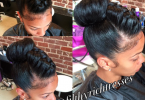French braid designs date back thousands of years. Otherwise known as ”invisible cornrows” the earliest French braid methods can be traced to Egyptian, Nigerian, and African roots, with the earliest appearance of them being, perhaps, around 500 B.C. as they have been found depicted in hieroglyphs and sculptures. You can even see cornrows in the head of the Sphinx in Egypt!
This hairstyle has always been a painstaking, time-consuming process. It can actually take hours to finish putting cornrows into a single head of hair. In fact, it is often the case that you may need to find time for two separate applications as it is a process that can indeed be very tiring for both your fingers and your eyes.
Of course, this process is well worth the time and energy that is invested in it. You can leave cornrows in for several weeks before you need to remove them. All this time you can wash them like normal hair, although you might want to apply some oil to the hair and scalp every now and again to ensure that they do not dry out.
The earliest of these braid designs were often used to distinguish people of specific regions, according to some historians. It was common to see people of a particular tribe or area wearing hair with similar patterns. You might also see coastal people, for instance, with beads or shells in their hair as well, as they were materials easily recovered from that area.
Over time, of course, this tradition was a bit lost, or at least restrained to those particular areas of the world. They were introduced to America after the slave trade, as native Africans brought their traditions with them and passed them down to future generations. These generations were then able to revive the lost art after the Black Pride Movement and the Civil Rights Movement of the 1960s, when outspoken, newly restored African Americans sought to get in touch with their cultural heritage through the wearing of traditional and natural hair styles.
Of course, these hairstyles are very common today, thanks in large part to the continuation of the art through education as well as the exposure that it gets in the media. Many professional athletes and performers in music and movies wear their hair this way because it is a way for them to establish both a personal identity as well as connect to their past.







